Related Research Articles
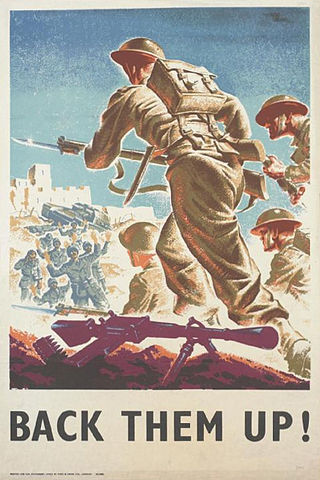
The military history of the United Kingdom in World War II covers the Second World War against the Axis powers, starting on 3 September 1939 with the declaration of war by the United Kingdom and France, followed by the UK's Dominions, Crown colonies and protectorates on Nazi Germany in response to the invasion of Poland by Germany. There was little, however, the Anglo-French alliance could do or did do to help Poland. The Phoney War culminated in April 1940 with the German invasion of Denmark and Norway. Winston Churchill became prime minister and head of a coalition government in May 1940. The defeat of other European countries followed – Belgium, the Netherlands, Luxembourg and France – alongside the British Expeditionary Force which led to the Dunkirk evacuation in June 1940.

Operation Dragoon was the code name for the landing operation of the Allied invasion of Provence on 15 August 1944. Although initially designed to be executed in conjunction with Operation Overlord, the Allied landing in Normandy, a lack of available resources led to a cancellation of the second landing. By July 1944 the landing was reconsidered, as the clogged-up ports in Normandy did not have the capacity to adequately supply the Allied forces. Concurrently, the High Command of the French Liberation Army pushed for a revival of the operation that would include large numbers of French troops. As a result, the operation was finally approved in July to be executed in August.

The Normandy landings were the landing operations and associated airborne operations on Tuesday, 6 June 1944 of the Allied invasion of Normandy in Operation Overlord during World War II. Codenamed Operation Neptune and often referred to as D-Day, it was, and still is, the largest seaborne invasion in history. The operation began the liberation of France and laid the foundations of the Allied victory on the Western Front.

Operation Cobra was an offensive launched by the First United States Army under Lieutenant General Omar Bradley seven weeks after the D-Day landings, during the Normandy campaign of World War II. The intention was to take advantage of the distraction of the Germans by the British and Canadian attacks around Caen in Operation Goodwood, and thereby break through the German defenses that were penning in their forces while the Germans were unbalanced. Once a corridor had been created, the First Army would then be able to advance into Brittany, rolling up the German flanks once free of the constraints of the bocage country. After a slow start, the offensive gathered momentum and German resistance collapsed as scattered remnants of broken units fought to escape to the Seine. Lacking the resources to cope with the situation, the German response was ineffectual and the entire Normandy front soon collapsed. Operation Cobra, together with concurrent offensives by the British Second Army and the Canadian First Army, was decisive in securing an Allied victory in the Normandy campaign.
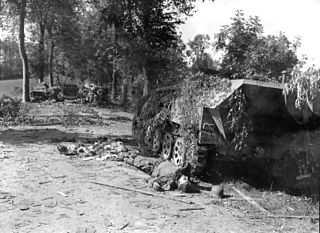
Operation Lüttich was the codename of the Nazi German counter-attack during the Battle of Normandy, which occurred near U.S. positions near Mortain, in northwestern France. Lüttich is the German name for the city of Liège, Belgium. In British and American histories of the Second World War, the German Operation Lüttich is known as the Mortain counter-attack, which Hitler ordered to regain territory gained by the First United States Army during Operation Cobra by reaching the coast of the Avranches region, which is at the base of the Cotentin peninsula, in order to isolate the units of the Third United States Army that had advanced into Brittany.
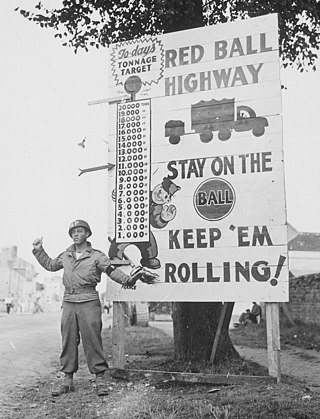
The Red Ball Express was a famed truck convoy system that supplied Allied forces moving quickly through Europe after breaking out from the D-Day beaches in Normandy in 1944. To expedite cargo shipment to the front, trucks emblazoned with red balls followed a similarly marked route that was closed to civilian traffic. The trucks also had priority on regular roads.

The Siegfried Line campaign was a phase in the Western European campaign of World War II, which involved actions near the German defensive Siegfried Line.

The Battle for Brest was fought in August and September 1944 on the Western Front during World War II. Part of the overall Battle for Brittany and the Allied plan for the invasion of mainland Europe called for the capture of port facilities, in order to ensure the timely delivery of the enormous amount of war materiel required to supply the invading Allied forces. It was estimated that the 37 Allied divisions to be on the continent by September 1944 would need 26,000 tons of supplies each day. The main port the Allied forces hoped to seize and put into their service was Brest, in northwestern France.


Quiberon Bay is an area of sheltered water on the south coast of Brittany. The bay is in the Morbihan département.

Clearing the Channel Coast was a World War II task undertaken by the First Canadian Army in August 1944, following the Allied Operation Overlord and the victory, break-out and pursuit from Normandy.
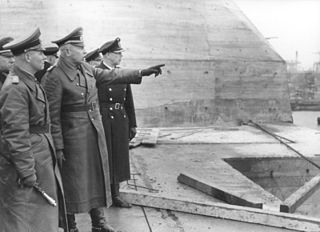
Wilhelm Fahrmbacher was a general in the Wehrmacht of Nazi Germany during World War II who commanded several corps, including VII Corps, XXV Corps and LXXXIV Corps, fighting on both the Eastern Front and Western Front.
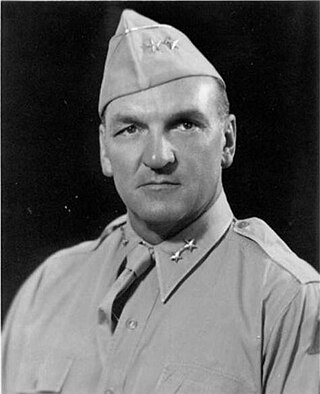
Major General John Shirley Wood was a United States Army officer who served in World War I and World War II. He is most notable for training and commanding the 4th Armored Division, which spearheaded General George S. Patton's Third Army drive across France in 1944 during World War II.

American logistics played a key role in the success of Operation Overlord, the Allied invasion of northwest Europe during World War II. The campaign officially commenced on D-Day, 6 June 1944, and ended on 24 July, the day before the launch of Operation Cobra. The Services of Supply (SOS) was formed under the command of Major General John C. H. Lee in May 1942 to provide logistical support to the European Theater of Operations, United States Army. From February 1944 on, the SOS was increasingly referred to as the Communications Zone (COMZ). Between May 1942 and May 1944, Operation Bolero, the buildup of American troops and supplies in the UK, proceeded fitfully and by June 1944 1,526,965 US troops were in the UK, of whom 459,511 were part of the COMZ.
The XXV Army Corps was an army corps of Germany's Wehrmacht during World War II.

American logistics in the Northern France campaign played a key role in the Allied invasion of northwest Europe during World War II. In the first seven weeks after D-Day, the Allied advance was slower than anticipated in the Operation Overlord plan because the well-handled and determined German opposition exploited the defensive value of the Normandy bocage country. The Northern France campaign officially commenced on 25 July, the day First United States Army began Operation Cobra, which saw the breakout from the Normandy lodgment, and ended on 14 September.

The Battle of Saint-Malo was fought between Allied and German forces to control the French coastal town of Saint-Malo during World War II. The battle formed part of the Allied breakout across France and took place between 4 August and 2 September 1944. United States Army units, with the support of Free French and British forces, successfully assaulted the town and defeated its German defenders. The German garrison on a nearby island continued to resist until 2 September.

The broad front versus narrow front controversy in World War II arose after General Dwight D. Eisenhower, the Supreme Allied Commander, decided to advance into Germany on a broad front in 1944, against the suggestions of his principal subordinates, Lieutenant Generals Omar Bradley and George S. Patton and Field Marshal Sir Bernard Montgomery, who argued instead to stage competing advances on narrow fronts. The decision was controversial initially because the British government wanted to raise the profile of the minority British contingent in what was by then an overwhelmingly American army, and they perceived that a British-lead thrust to Berlin would achieve this aim. Montgomery's strident advocacy raised political and nationalistic complications that strained the wartime alliance. During the subsequent Cold War, suggestions were made that the Soviet presence in Eastern Europe may have been reduced had Eisenhower sent a narrow-front thrust to race the USSR to Berlin in 1945.

American transportation played a crucial part in the military logistics of the World War II Siegfried Line campaign, which ran from the end of the expulsion of the German armies from Normandy in mid-September 1944 until December 1944, when the American Army was engulfed by the German Ardennes offensive. In August 1944, the Supreme Allied Commander, General Dwight D. Eisenhower, elected to continue the pursuit of the retreating German forces beyond the Seine instead of pausing to build up supplies and establish the lines of communication as called for in the original Operation Overlord plan. The subsequent advance to the German border stretched the American logistical system to its breaking point, and the advance came to a halt in mid-September.
The battle for Brittany took place between August and October 1944. After the Allies broke out of Normandy in June 1944, Brittany became targeted for its well developed ports which the Allies intended to use, whilst also stopping their continued use by German U-boats.
References
- ↑ Chant, Christopher (1986). The Encyclopedia of Code Names of World War II. London: Routledge and Kegan Paul. p. 77. ISBN 0710207182.
- ↑ Bickley, David. "The Americans in Brittany (4); Operation Hands Up" (PDF). Retrieved May 2, 2009.